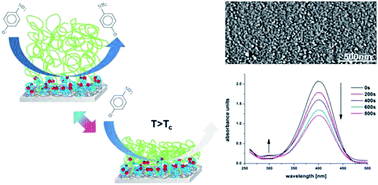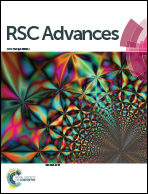Nanocomposite coatings with stimuli-responsive catalytic activity†
Abstract
Stimuli-responsive catalytic coatings are fabricated by in situ-synthesis of metallic nanoparticles in binary PNIPAM–P2VP (poly(N-isopropyl acrylamide)–poly(2-vinyl pyridine)) brushes. The amount of immobilized nanoparticles is found to be controllable by the polymer ratio, since solely P2VP interacts with the nanoparticles. The in situ-synthesis of nanoparticles is studied by attenuated total reflection Fourier transform infrared spectroscopy and atomic force microscopy, whereas the swelling behavior of the polymer films is investigated by spectroscopic ellipsometry and grazing incidence small angle X-ray scattering. Temperature dependent catalytic activity is probed by use of the reduction of nitrophenol to aminophenol as a model reaction. Control of the catalytic activity by the temperature induced deswelling of PNIPAM is observed.


 Please wait while we load your content...
Please wait while we load your content...